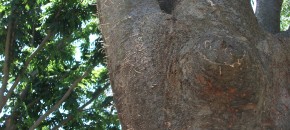The early-planted corn fields should have been sprayed postemergence for later emerging weeds. In later planted fields, morningglories can be a challenge. Glyphosate is quite effective on small morningglories, but when they start to “run” or develop the vining growth habit, glyphosate is not as effective. If morningglories are an issue for your field, you […]
Continue reading...Not All “Buggy-Whipping” in Corn is Due to Herbicides
Buggy-whipping in corn is a common sight early in the growing season and later under certain environmental conditions. The cause of buggy whipping is the abnormal formation of waxy leaf layers causing leaves to unfurl improperly. Agrichemicals and environment can cause this.
Continue reading...Tankmixing Reflex (fomesafen) with Glyphosate
There have been many situations where both fomesafen (active ingredient in Reflex) and glyphosate will complement each other for weed control. Syngenta has a premix of fomesafen plus glyphosate called Flexstar GT. Also, Reflex and glyphosate can be tankmixed, but there have been some situations of these two products not mixing well. The following is […]
Continue reading...They’re Everywhere! They’re Everywhere!

Asian Longhorned Beetle and now the Emerald Ash Borer garner all the attention, but a group of tiny exotic wood boring beetles, known as “Asian Ambrosia Beetles,” has been quietly invading the state for the last decade. First appearing in our laboratory database in 2006, by 2008 these beetles had found widespread distribution in the […]
Continue reading...Potato Disease Forecasting Report 6-10-14
Potato Disease Forecasting Report 6-10-14 – Click to Download We will be tracking DSVs for Late blight development and calculating P-days for initiating the first early blight fungicide application. The first late blight fungicide application is recommended once 18 DSVs accumulate from green row. Green row typically occurs around the first week in May in southern […]
Continue reading...Tomato Disease Forecasting Report 6-10-14
6-10-14 Tomato Report – Click to Download Disease severity values (DSVs) for early blight, septoria leaf spot, and tomato anthracnose development are determined daily based on leaf wetness (due to rainfall, dew) and air temperature. On a daily basis DSV values can range from 0 to 4 where 0 = no chance for disease development […]
Continue reading...